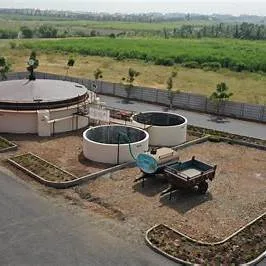Anaerobic digestion is a biochemical process that converts organic materials, particularly agricultural waste, into biogas. This gas is primarily composed of methane (CH₄) and carbon dioxide (CO₂). This renewable technology offers a sustainable alternative to fossil fuels, with broad applications in rural and agro-industrial energy systems.
1. Process Description and Functionality
An anaerobic biogas digester operates in the absence of oxygen and utilizes microbial consortia to break down biodegradable material. The main outputs are:
-
Biogas (60–70% CH₄) – used as fuel for heating, electricity generation, or as vehicle fuel after purification.
-
Digestate – the residue, used as organic fertilizer or soil conditioner.
Process Schematic:
2. Types and Configurations of Digesters
-
Fixed-dome digester: Underground, low-cost, with minimal maintenance.
-
Floating-drum digester: Steel drum collects gas; easier to monitor gas volume.
-
Plug-flow digester: Long and narrow; suitable for solid manure from cattle or buffalo.
-
CSTR (Continuous Stirred Tank Reactor): Common in industrial applications; ensures uniform mixing and temperature.
3. Design Parameters and Calculation Steps
3.1. Feedstock Estimation
For agricultural waste (e.g., cow dung, rice husk, corn stalks):
-
Volatile Solids (VS) are used as the basis for methane potential.
-
Methane yield: 0.2–0.5 m³ CH₄/kg VS added.
3.2. Reactor Volume (Vr)
Formula: Vr = (Q × HRT) / f
Where:
Q = Daily feedstock input (m³/day)
HRT = Hydraulic Retention Time (days)
f = Digester loading factor (commonly 0.6–0.8)
3.3. Biogas Production (Bg)
Formula:
Bg = VS × Ym
Where:
VS = Daily volatile solids input (kg/day)
Ym = Methane yield per kg VS
Sample Biogas Yield Graph:
4. Material Selection
Common materials include:
-
Concrete (reinforced): Most common for rural digesters.
-
Mild steel or stainless steel: For tanks and industrial units.
-
HDPE/FRP: Suitable for portable and modular digesters.
5. International Standards and Guidelines
-
ISO 20675:2018: Biogas — Requirements for production plants.
-
IEC 62282-3-201: Fuel cells using biogas as feedstock.
-
ASABE S607: Testing and measurement standards for anaerobic digesters.
-
UNFCCC CDM: Methodology for emission reduction certification.
6. Energy and Material Balance
6.1. Energy Balance
Input: Organic matter (chemical energy) + thermal energy
Output: Biogas (21–23 MJ/m³) used for cooking, lighting, or CHP.
6.2. Material Balance
Organic Waste → Biogas (CH₄ + CO₂) + Digestate
Example: 1 ton of cow manure → ~150 m³ biogas + ~700 kg digestate
7. Environmental and Economic Benefits
-
Reduces fossil fuel usage
-
Captures methane emissions, reducing greenhouse gases
-
Improves sanitation and reduces odors
-
Converts waste into valuable fertilizer
8. Common Byproducts and Their Uses
-
Solid Digestate: Compost or fuel pellets
-
Liquid Digestate: Organic nutrient-rich fertilizer
-
CO₂: Can be captured and used in food-grade or industrial processes
9. Case Study: Farm-based Biogas Plant in India
A dairy farm with 150 cows in Maharashtra, India, installed a plug-flow biogas digester with 50 m³ capacity. Daily input of 3 tons of cow manure produced 180 m³/day of biogas. The gas was used for milk pasteurization and lighting, reducing monthly diesel costs by 70%. Digestate was sold locally as organic fertilizer.
Biogas Plant on Farm:
Conclusion
Anaerobic digestion of agricultural waste is a proven and scalable technology that supports sustainable energy and waste management systems. With proper design based on scientific calculations, material selection, and adherence to standards, a biogas digester can provide significant environmental and economic value, particularly in rural and agro-industrial regions.
📌 If
you are interested in seeing articles that are relevant to this field, you can
find them 👉 here







